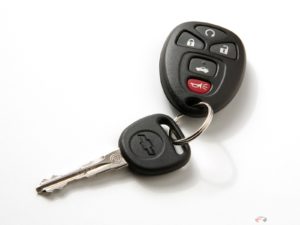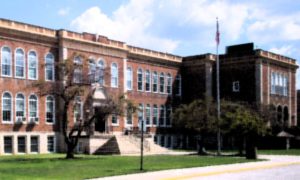Hi! I’m Margaret Carnahan, and I teach math at Hamptonville High School.
Sunday I went to the family reunion in the park. I got out of the car, tossed the keys on the seat, and shut the driver’s door so I could unload the casserole in the back seat. Well, I must have bumped the lock, because when I went to open the back door, it wouldn’t open. I had locked my keys in the car!

Now, there are buttons for a 5-digit code on the door handle, but I never learned that code. I never thought I’d need it.
So I had to borrow a cell phone from my cousin so I could call roadside assistance. And THEY said they were so sorry, but my account with them had expired 6 weeks ago, and would I like for them to call me a tow truck?
It was a Sunday afternoon, and I knew it would be pricey, but what else could I do? I said yes. And after a little bit, a big white tow truck showed up. And who should be driving but Brian Clayton! Do you remember him? Brian graduated from Hamptonville High School about 6 or 7 years ago. I had him for 8th grade math and then again for algebra. Nice kid. Not real fond of math, but a nice kid.
And he jumps out of the truck and says, “Mrs. Carnahan! How are you?” And we catch up for a second, and then he says, “So … what’s up with your car?” And I told him I locked my keys inside, and he said, “You know, you’ve got a 5-digit code for this handle here.” And I said, “Yeah, but I never learned it. I never thought I’d need it.”
So he gets out this thing that looks like a blood pressure cuff and in a few moments, the car door is open.
And then he says, “Mrs. Carnahan, I’m afraid that’ll be $75.00.”
I said, “Right!” and reached into my car to grab my purse.
And it wasn’t there. And in that moment I remembered that I picked up the casserole from the kitchen table, but I left my purse there. I didn’t have any money. I didn’t have my checkbook. I started to wonder if I could pass the hat among my cousins – and then I had a thought.
“Brian,” I asked, “do you take credit cards?”
He looked at me like I was nuts. “Of course, Mrs. Carnahan!”
“Give me a piece of paper.”
Now, I shop online all the time. I know my credit card number. I wrote it all down – all 16 digits, the expiration date, the security code – I wrote down $75.00, I even gave him a tip. I signed it and handed it to him.
And Brian took that piece of paper and looked at it. And then he looked at me. And then he looked at the paper, and he said, “Mrs. Carnahan, how come you know your whole credit card number, the expiration date, and the security code, but you don’t know the 5-digit code for your door handle?”
I said, “Yeah, Brian, but I never use it, so I never learned it.”
And he said, “Mrs. Carnahan, I told you I would never use algebra, and you made me learn it anyway.”
And do you know, he would not let me go back to the family reunion until I had looked up that number and recited it for him three times.

